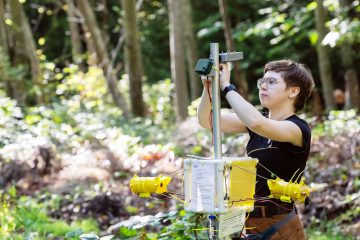How Artificial Lights at Night Impact Insects and Bats

Researchers at UBC Farm may not conduct their research under the cover of darkness, but they are certainly getting a sense of what insects are up to during the night. These days, however, darkness is a relative term with the proliferation of humanmade artificial light at night (ALAN). Master’s student Daphne Chevalier is seeking to better understand its impact.
“Artificial light at night is a huge threat,” says Chevalier, a student in the LFS Plant-Insect Ecology & Evolution Lab working under co-supervisors Drs. Juli Carrillo and Quentin Geissmann. “The dark sky is something that’s so incredibly valuable and those of us who live in cities tend to forget about that because we’re so used to having a sky that’s light-polluted.”
“But light is super important to insects’ foraging, navigation, camouflage, and reproduction, and they are often very sensitive to changes in colour and intensity.”
Artificial light is not only a problem in cities. Rural areas are also seeing increases in street lighting and from less expected sources: greenhouses in farm fields become beacons of light pollution in otherwise dark and biodiversity-rich areas.
Chevalier’s project piggy-backs off the Sticky Pi project, which uses artificial intelligence to photograph and identify insects in real time. She has added lights, light sensors, pitfall traps, and bat recorders to 12 Sticky Pi instruments that are placed far apart around the UBC Farm. Chevalier herself designed the light systems, which she’s calling ALANizers. The sensors collect data on light intensity and colour, while the Sticky Pis, pitfall traps, and bat recorders collect information on insect and bat activity.
The colour of artificial lights could change the impact on insects and is important to study now as many municipalities shift from the dim amber glow of sodium vapour bulbs to cheaper, brighter, and whiter LED lights. Chevalier’s study features both amber and white light, as well as darkness controls.
“We see under those different conditions — white, amber and darkness — how the number of insects we’re capturing changes and which kinds of insects are most affected,” says Chevalier.
“Once we have that information, we can compare it to our bat activity data from the bat recorders and see if any changes we’ve observed in insect activity might match up to changes in bat activity. All B.C. bats eat insects, and it’s important that they are active at the same time as their prey. If a group of insects are active earlier or later under artificial light, will the bats that eat them also shift their activity to match? If not, they might start predating a different group of insects
instead, with unpredictable consequences.”
She hopes that her study will show if one colour of light is better than the other, and that this evidence will inform regulations and guidelines.
“It’s so important to understand how the light that we’re introducing to the environment is impacting all of these different creatures,” adds Chevalier. “They really are the foundation of ecosystems and of our food system.”
Chevalier began collecting data in June 2023 and will finish collecting data at the end of the year. To find out more about this project and the PIEE lab, visit: piee-lab.landfood.ubc.ca.
Tagged with: 2023, Applied Biology, Faculty
